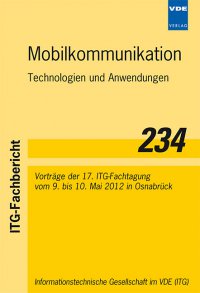Uplink System Performance of LTE-Advanced Relay Deployments in Different Propagation Environments
Conference: Mobilkommunikation - 17. ITG-Fachtagung
05/09/2012 - 05/10/2012 at Osnabrück, Deutschland
Proceedings: Mobilkommunikation
Pages: 6Language: englishTyp: PDF
Personal VDE Members are entitled to a 10% discount on this title
Authors:
Bulakci, Ömer (NSN Research-Radio Systems, Nokia Siemens Networks, St.-Martin-Str. 76, 81541, Munich, Germany )
Saleh, Abdallah Bou; Hämäläinen, Jyri (Aalto University School of Electrical Engineering, FIN-00076, Helsinki, Finland)
Redana, Simone (NSN Research-Radio Systems, Nokia Siemens Networks, St.-Martin-Str. 76, 81541, Munich, Germany)
Abstract:
Relay deployments promise to alleviate the limitations of conventional macrocell networks such as poor indoor penetration and coverage holes in a cost-efficient way. To this end, Type 1 inband relaying has been standardized in 3GPP LTE-Advanced as an enhancement to existing radio access networks. This type of relay nodes supports a relaying mode where the relay link transmission is time-division multiplexed with the access link transmission, whereas macro users share the same resources with the relays. Hence, system performance depends on the resource sharing strategy among and within the links as well as how well the competition on resources is managed at the eNB. Moreover, in order to fully exploit the benefits of relaying, power control optimization should be jointly done on all links, i.e. on eNB-relay, eNB-user and relay-user links, taking into account applied resource sharing strategy. Besides, due to their low transmit power level in downlink, relay cells have smaller cell coverage, which creates inefficient load distribution among the macro and relay cells and an imbalance between downlink and uplink. In this context, relay cell range extension is an effective tool to tackle these issues. Nevertheless, the system performance of relays, as any other radio access point, significantly depends on the propagation characteristics of the deployment environment. In this work, performance evaluation of relay deployments is carried out within the LTE-Advanced uplink framework in different propagation environments. Both 3GPP urban and suburban scenarios are analyzed considering various radio resource management (RRM) optimization strategies, where Taguchi’s method is utilized.


